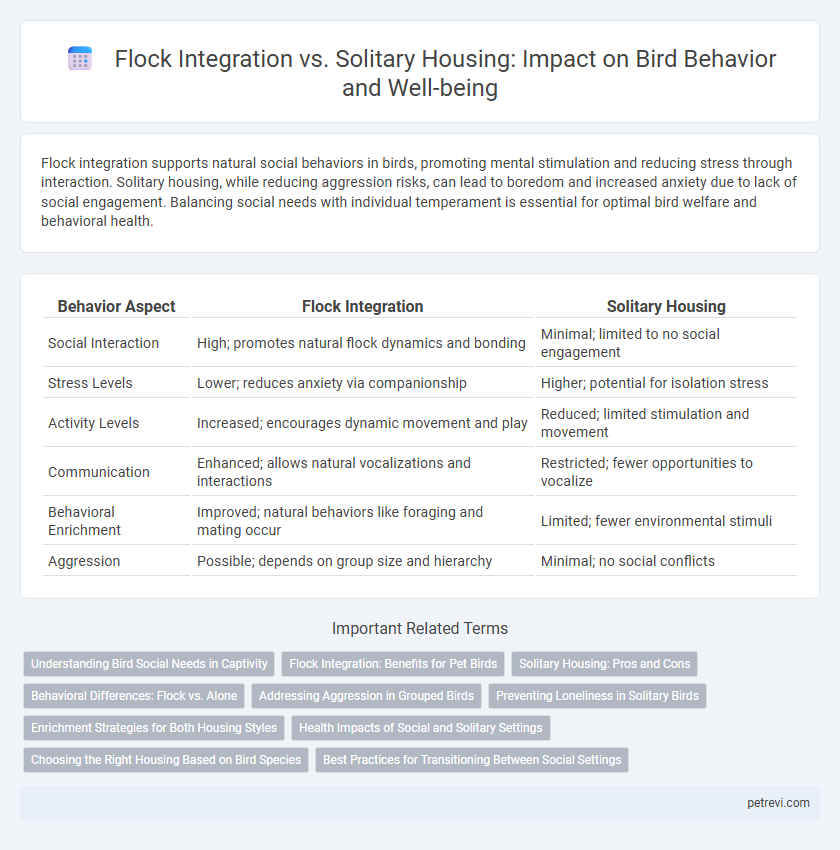Flock integration supports natural social behaviors in birds, promoting mental stimulation and reducing stress through interaction. Solitary housing, while reducing aggression risks, can lead to boredom and increased anxiety due to lack of social engagement. Balancing social needs with individual temperament is essential for optimal bird welfare and behavioral health.
Table of Comparison
| Behavior Aspect | Flock Integration | Solitary Housing |
|---|---|---|
| Social Interaction | High; promotes natural flock dynamics and bonding | Minimal; limited to no social engagement |
| Stress Levels | Lower; reduces anxiety via companionship | Higher; potential for isolation stress |
| Activity Levels | Increased; encourages dynamic movement and play | Reduced; limited stimulation and movement |
| Communication | Enhanced; allows natural vocalizations and interactions | Restricted; fewer opportunities to vocalize |
| Behavioral Enrichment | Improved; natural behaviors like foraging and mating occur | Limited; fewer environmental stimuli |
| Aggression | Possible; depends on group size and hierarchy | Minimal; no social conflicts |
Understanding Bird Social Needs in Captivity
Flock integration enhances bird social interaction, reducing stress and encouraging natural behaviors such as preening and vocal communication, essential for their psychological well-being. Solitary housing often leads to increased anxiety and stereotypic behaviors due to the absence of social stimuli critical for species naturally inclined to group living. Understanding these social needs is crucial for improving captive bird welfare and fostering environments that mimic their natural social structures.
Flock Integration: Benefits for Pet Birds
Flock integration enhances pet birds' social skills and reduces stress by mimicking their natural environment, promoting mental stimulation and overall well-being. Birds housed in groups exhibit more natural behaviors like grooming, vocalizing, and foraging, which contributes to healthier physical and emotional states. Providing opportunities for flock interaction supports stronger bonds and decreases the risk of behavioral issues commonly seen in solitary housing.
Solitary Housing: Pros and Cons
Solitary housing in birds allows for controlled monitoring of individual health, reduces risks of aggression, and minimizes the spread of contagious diseases, making it beneficial in clinical or quarantine settings. However, it can lead to increased stress, boredom, and abnormal behaviors such as feather plucking due to lack of social interaction, negatively impacting mental well-being and natural behavior expression. Balancing solitary housing duration with enrichment strategies is essential to mitigate adverse effects while achieving necessary management goals.
Behavioral Differences: Flock vs. Alone
Birds housed in flocks exhibit increased social behaviors such as vocal communication, grooming, and cooperative foraging, reflecting their natural instincts for group living and enhanced mental stimulation; solitary birds often display increased stress, repetitive behaviors, and decreased activity levels due to isolation. Flock integration encourages natural hierarchies and social bonding, which can improve overall welfare and reduce aggression when space and resources are adequate. In contrast, solitary housing limits social interaction, potentially leading to behavioral abnormalities and a decline in psychological health.
Addressing Aggression in Grouped Birds
Flock integration reduces stress and aggressive behaviors in birds by promoting social interactions and natural hierarchy formation within the group. Solitary housing often leads to increased frustration and repetitive behaviors due to lack of social stimulation, which can exacerbate aggression when birds are eventually grouped. Implementing environmental enrichment and gradual introductions within flock settings significantly mitigates conflict and supports healthier social dynamics among birds.
Preventing Loneliness in Solitary Birds
Flock integration in birds significantly reduces stress and promotes natural social behaviors, preventing loneliness commonly observed in solitary housing. Birds housed in flocks exhibit increased vocalization, grooming, and foraging activities, which are essential for their mental and emotional well-being. Solitary birds, lacking social interaction, are prone to anxiety, depression, and behavioral issues, making flock housing crucial for their overall health.
Enrichment Strategies for Both Housing Styles
Flock integration enhances natural social interactions and reduces stress in birds by promoting group dynamics that stimulate communication and play behavior. Solitary housing benefits from targeted enrichment strategies such as interactive toys, foraging puzzles, and auditory stimulation to prevent boredom and encourage mental engagement. Both housing styles require tailored environmental complexity and regular social or sensory stimuli to support optimal cognitive and emotional well-being in captive birds.
Health Impacts of Social and Solitary Settings
Flock integration promotes natural social behaviors in birds, reducing stress and enhancing immune function due to increased interaction opportunities. Solitary housing often leads to behavioral issues like feather plucking and heightened cortisol levels, indicating chronic stress and reduced well-being. Studies show that birds in social settings exhibit better overall health markers, including greater lifespan and lower incidence of respiratory infections.
Choosing the Right Housing Based on Bird Species
Choosing the right housing based on bird species significantly impacts behavioral health and social interaction. Flock integration is beneficial for species such as parrots, finches, and doves that naturally thrive in social groups, promoting natural behaviors and reducing stress. Solitary housing is preferable for territorial or aggressive species like hawks and certain parrots, ensuring safety and preventing conflicts.
Best Practices for Transitioning Between Social Settings
Transitioning birds from solitary housing to flock integration requires gradual acclimatization to reduce stress and aggression, starting with visual and auditory exposure before direct contact. Providing ample space, perches, and enrichment items supports natural social behaviors and prevents territorial disputes. Monitoring interactions closely ensures early detection of conflicts, promoting a harmonious adaptation to new social environments.
Flock Integration vs Solitary Housing for Bird Behavior Infographic

 petrevi.com
petrevi.com